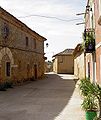Valdunquillo | |
|---|---|
 Palace of the Dukes of Alba | |
 Location of Valdunquillo | |
| Coordinates: 42°2′0″N 5°43′19″W / 42.03333°N 5.72194°W | |
| Country | |
| Autonomous community | |
| Province | Valladolid |
| Comarca | Tierra de Campos |
| Judicial district | Medina de Rioseco |
| Founded | See text |
| Government | |
| • Alcalde | Máximo Baza Pastor (2007) |
| Area | |
| • Total | 30.8 km2 (11.9 sq mi) |
| Elevation | 741 m (2,431 ft) |
| Population (2018)[1] | |
| • Total | 133 |
| • Density | 4.3/km2 (11/sq mi) |
| Time zone | UTC+1 (CET) |
| • Summer (DST) | UTC+2 (CEST) |
| Postal code | 47672 |
| Dialing code | 983 |
| Official language(s) | Spanish |
| Website | Official website |
Valdunquillo is a municipality located in the province of Valladolid, Castile and León, Spain. According to the 2004 census (INE), the municipality has a population of 179 inhabitants. The town's residents traditionally call themselves "lechugeros," a testament to the fact that the town had a good reputation for cultivating lettuce. Valdunquillo is adjacent to the towns La Unión de Campos, Villalogán, Bolaños de Campos, Valderas, Medina de Rioseco, and Villavicencio de los Caballeros.











